Trees Birds Mammals Fish Amphibians Reptiles
Wild Algarve
Bookshop
Lycoperdon utriforme Bull. - Mosaic Puffball
Phylum: Basidiomycota - Class: Agaricomycetes - Order: Agaricales - Family: Agaricaceae
Distribution - Taxonomic History - Etymology - Identification - Culinary Notes - Reference Sources
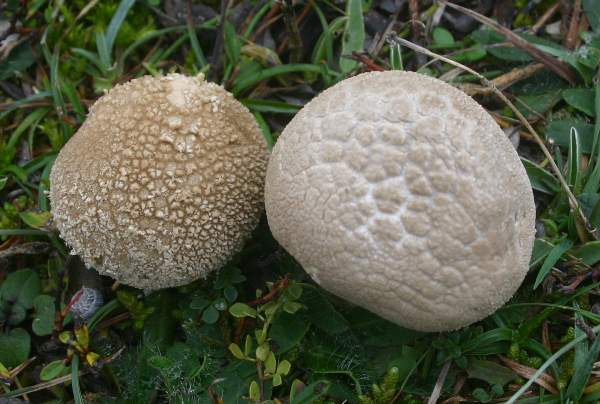
Lycoperdon utriforme, the Mosaic Puffball, is very attractive member of the gasteromycetes group of fungi, also known as the stomach fungi. Members of this group are not all closely related genetically, but some mycologists specialise in fungi that grow in various 'ball' forms. Lycoperdon utriforme is one of the most attractive members of this group.
These largish and sometimes gregarious puffballs are easy to identify when they are young, but older specimens lose their distinctive patterning.
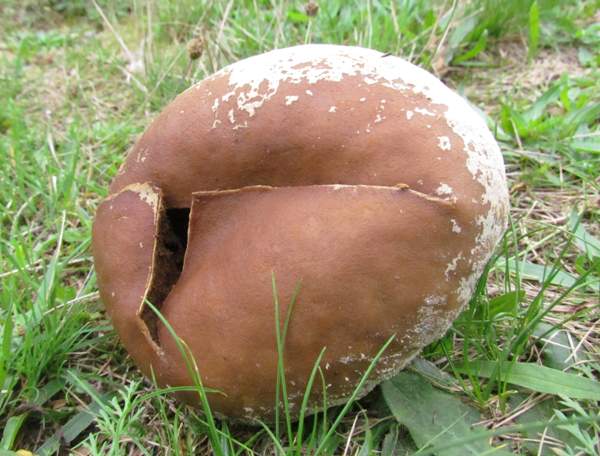
Distribution
A occasional find in Britain and Ireland, the Mosaic Puffball fruits most often in scattered groups in unimproved grassland and occasionally on woodland edges. Lycoperdon utriforme is a worldwide fungus. This puffball is also quite common and widespread throughout central mainland Europe and Asia as well as Africa, and has also been found in New Zealand and in Chile.
Taxonomic history
This species was first described in scientific literature by French naturalist Jean Baptiste Francois (Pierre) Bulliard in 1791, when he gave it the binomial name Lycoperdon utriforme which remains its accepted scientific name today. Even so, Lycoperdon utriforme has acquired a few synonyms including Lycoperdon bovista Pers., Calvatia utriformis (Bull.) Jaap, and Handkea utriformis (Bull.) Kreisel.
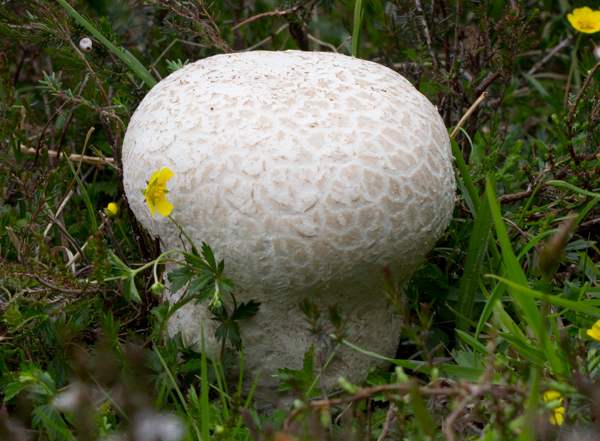
Etymology
When this gastromycete fungus was first described scientifically, it was given the specific epithet utriforme, which means 'shaped like a womb'. The common name Mosaic Puffball refers to the mosaic-like pattern of flakes that cover the surface of fruitbodies when they are young.
The genus name Lycoperdon literally means 'wolf's flatulence' and begs the question who got close enough to a wolf to become an expert on the matter. For most of us, surely such an odour cannot be considered a particularly helpful diagnostic feature for identifying the Mosaic Puffball, Lycoperdon utriforme.
Identification guide
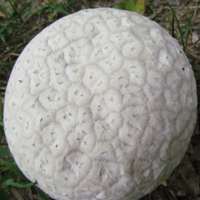 |
Fruitbody
Typically subspherical to pear shaped, 6 to 15cm across and up to 15cm tall. A surface covered in roughly similarly-sized but irregularly-shaped flakes, rather like crazy paving, distinguishes the Mosaic Puffball from its many similar
relatives. (At least 13 Lycoperdon species occur in the UK.) |
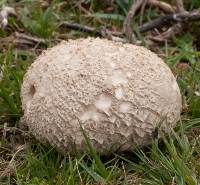 |
The scales on the outer peridium fall away as the fruitbody matures, and the fruitbody turns greyish brown and eventially ruptures, usually via apical tears, allowing wind and rain to disperse the mature spores. |
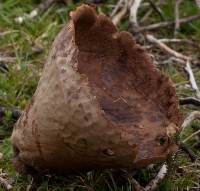 |
It is not uncommon to find disintegrating Mosaic Puffballs disconnected from the soil and rolling about in the wind.
The base of a Mosaic Puffball is more or less a blunt-ended inverted cone; it contains a small amount of spongy, infertile material that persists long after the spores have been distributed. |
|
Spores
Spherical, smooth; 4-6µm in diameter.
Spore mass
Initially white and firm, turning yellowish-brown and then olive-brown and powdery. At maturity, the top of the fruitbody tears irregularly to release the spores, and the fruitbody disintegrates from the top to leave a short infertile base that may persist for several months. |
Odour/taste |
Not distinctive. |
Habitat & Ecological role |
Mosaic Puffballs are saprotrophic and occur in grassland, particularly in permanent pasture and on sheep-cropped hillsides. |
Season |
July to November in Britain and Ireland. |
Similar species |
Lycoperdon echinatum is darker, with a reddish tinge, and is
covered in spines.
Lycoperdon mammiforme is white at first and then its surface
breaks up into flaky cream scales that eventually fall off (or may be easi;ly rubbed off). |
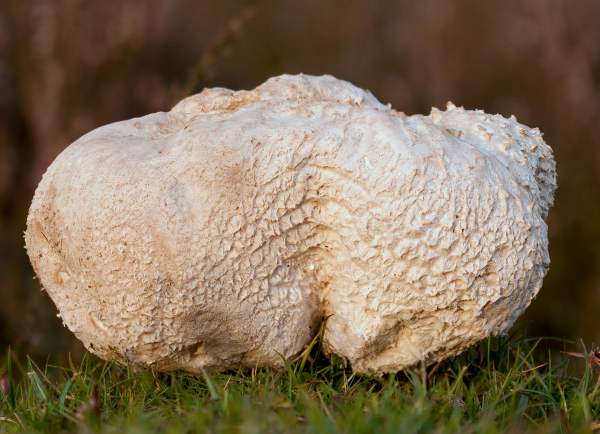
Culinary notes
Lycoperdon utriforme is not one of the 'Magnificent Seven' edible fungi featured in chapter 10 of Fascinated by Fungi, but if gathered when very young this is a fairly good edible mushroom and can make a good meal if prepared and cooked properly. Here are a couple of tips. The first important step is to remove the tough outer skin and infertile stem - a fiddly job perhaps best done with a sharp knife. The second point is all to do with quality: use only fresh young fruitbodies which, when cut in half along the vertical axis, are white all through. Discard any that have begun turning yellow, olive or brown, as this indicates that the spores are maturing and the flavour will be seriously marred if you include them in your dish. Probably the simplest meal that you can make with puffballs is a mushroom omelet; they can also be fried or used to make soups.
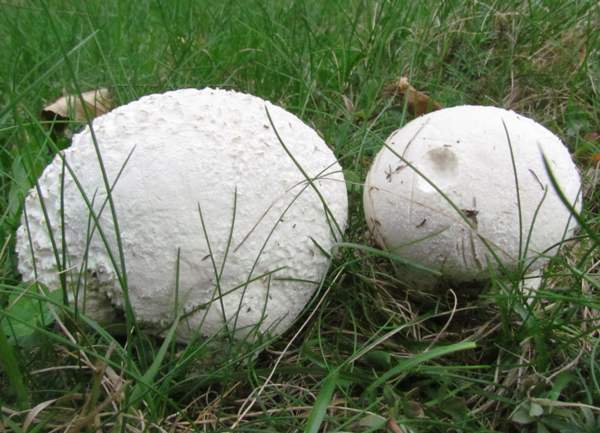
Toxic imposters
Here is a note of caution for newcomers to fungal foraging: there are ball-shaped fungi known as earthballs, and some of them can look quite similar to Mosaic Puffballs; however, the spore-bearing inner material of these thick-skinned gasteromycete fungi starts off very pale grey and gradually becomes brown or black as the spores mature.
Earthballs are inedible and some of them can cause serious poisoning. The most common of these, found on woodland tracks (and sometimes along with common puffballs), is Scleroderma citrinum, the Common Earthball.
The differences in features between puffballs and earthballs are quite obvious once you know what to look for, but it is important to learn how to distinguish these two groups if you plan on gathering edible puffballs for the pot.
There are also some poisonous gilled mushrooms which, when young, could be mistaken for Lycoperdon utriforme, the Mosaic Puffball. Amanita muscaria, the Fly Agaric, first appears as a white-warted round button - the red cap skin does not show through until the cap has expanded somewhat - and at that stage it could quite easily be mistaken for a Mosaic Puffball. Even more seriously, the infamous Deathcap, Amanita phalloides, starts off as a rounded button mushroom, sometimes pure white or with just the faintest hint of olive. I mention this simply to emphasise how important it is not merely to learn how to identify a range of the finest edible mushrooms but, equally importantly, to become familiar with the identifying characteristics of the poisonous fungi with which they could be confused. For more help with this important safety matter see Fascinated by Fungi; however, some introductory information on edible fungi with toxic imposters online here...
For a very easy to recognise edible puffball that cannot be mistaken for any other mushroom, see Calvatia gigantea, the Giant Puffball. Unfortunately it's not every day that you stumble across Giant Puffballs, as they are not only uncommon but also very localised in their distribution. If you find a good spot for these mighty meaty meal sources, make a note of it because Giant Puffballs, like Mosaic Puffballs, usually reappear in the same places for many years.
Reference Sources
Fascinated by Fungi, 2nd Edition, Pat O'Reilly 2016, reprinted by Coch-y-bonddu Books in 2022.
Pegler, D.N., Laessoe, T. & Spooner, B.M (1995). British Puffballs, Earthstars and Stinkhorns. Royal Botanic Gardens, Kew.
Ellis, M.B. & Ellis, J.P. (1990). Fungi without Gills (Hymenomycetes and Gasteromycetes). Chapman and Hall: London, England.
British Mycological Society. English Names for Fungi
Dictionary of the Fungi; Paul M. Kirk, Paul F. Cannon, David W. Minter and J. A. Stalpers; CABI, 2008
Taxonomic history and synonym information on these pages is drawn from many sources but in particular from the British Mycological Society's GB Checklist of Fungi.
Acknowledgements
This page includes pictures kindly contributed by David Kelly.
Top of page...
Fascinated by Fungi. Back by popular demand, Pat O'Reilly's best-selling 450-page hardback book is available now. The latest second edition was republished with a sparkling new cover design in September 2022 by Coch-y-Bonddu Books. Full details and copies are available from the publisher's online bookshop...